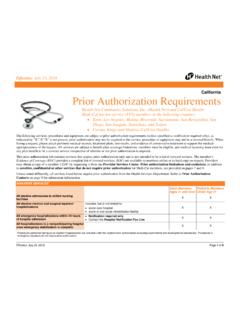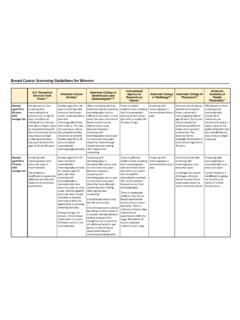Transcription of 2021 Adult Preventive Health Guidelines
1 1. 2021 adult preventive health guidelines Important Note Health Net's Preventive Health Guidelines provide Health Net members and practitioners with recommendations for Preventive care services for the general population, based on the recommendations of recognized clinical sources such medical associations and specialty societies, professional consensus panels, and government entities such as the Center for Disease Control and Prevention (CDC) and the United States Preventive Services Task Force (USPSTF). They are based on the best available medical evidence at the time of release. These Guidelines apply to those individuals who do not have symptoms of disease or illness.
2 A Health Net member's medical history and physical examination may indicate that further medical tests are needed. Guidelines may also differ from state to state based on state regulations and requirements. As always, the judgment of the treating physician is the final determinant of member care. Member benefit plan may or may not cover all the services listed here. Please refer to the certificate of coverage for complete details or contact the customer service number listed on the member's ID card. KEY TO MAJOR PROFESSIONAL ORGANIZATIONS REFERENCED IN THE Guidelines . AAP: American Academy of Pediatrics ACIP: Advisory Committee on Immunization Practices of the CDC.
3 ACS: American cancer Society ACOG: American Congress of Obstetricians and Gynecologists ACPM: American College of Preventive Medicine (ACPM. AAFP: American Academy of Family Practice AHA: American Heart Association ADA: American Diabetes Association AMA: American Medical Association AUA: American Urological Association CDC: Centers for Disease Control and Prevention NCI: National cancer Institute USPSTF: Preventive Services Task Force Routine Health Frequency based on age and contract (annual 2 years). Examination Baseline height and weight Calculation of Body Mass Index Obesity: Clinicians should offer or refer patients with a body mass index (BMI) of 30 kg/m2 or higher to intensive, multicomponent behavioral interventions.)
4 (USPSTF). Blood Pressure Measurement including outside the clinical setting (USPSTF). Abdominal Aortic One-time screening for abdominal aortic aneurysm (AAA) with ultrasonography Aneurysm in men ages 65 to 75 years who have ever smoked Source USPSTF. breast cancer Note that different entities have different recommendations. All recommend shared decision-making as to age, frequency and risk factors 2. Some states regulations allow for baseline mammography starting at age 35. USPSTF. Biennial screening mammography for women aged 50 to 74 years at average risk. The decision to start screening mammography in women prior to age 50.
5 Years and to continue past the age of 74 should be an individual one ACOG. Women at average risk should be offered mammography at age 40 but should start at 50. Women at average risk of breast cancer should have screening mammography every one or two years based on an informed, shared decision- making process Beyond age 75 years, the decision to discontinue screening mammography should be based on a shared decision making. American cancer Society (average risk). Women 40 44 years of age annual if desired Women 45-45 annual Women 55 and older could switch to every 2 years Sources: USPSTF, ACOG, ACS.
6 BRCA TESTING: Providers should assess women with a personal or family history of breast , ovarian, tubal, or peritoneal cancer or who have an ancestry associated with breast cancer susceptibility 1 and 2 (BRCA1/2) gene mutations with an appropriate brief familial risk assessment tool. Women with a positive result on the risk assessment tool should receive genetic counseling and, if indicated after counseling, genetic testing. Source: USPSTF 2019. Cervical cancer Screening Cervical cancer screening should begin at age 21 years. Women younger than 21 should not be screened, except for women who are infected with HIV.
7 More frequent screening is appropriate for certain women, including those infected with HIV. Cervical cytology alone should be used for women aged 21 to 29 years, and screening should be performed every three years unless there is an abnormal result. In women aged 30 65 years, screening with cytology alone every 3 years or hrHPV testing alone ever 5 yrs is acceptable. Annual screening need not be performed unless there is an abnormal result. Women younger than 30 years should not undergo co-testing. Screening should be discontinued after age 65 years in women with adequate negative prior screening test results.
8 Routine cytology and HPV testing should be discontinued and not restarted for women who have had a total hysterectomy and never had cervical intraepithelial neoplasia 2 or higher. Women who have a history of cervical cancer , have HIV infection, are immunocompromised, or were exposed to diethylstilbestrol in utero should not follow routine screening Guidelines and may need more frequent screening. 3. Adequate negative prior screening results are defined as three consecutive negative cytology results or two consecutive negative co-test results within the previous 10 years, with the most recent test performed within the past 5 years.
9 Source: ACOG and USPSTF. Colorectal cancer (CRC) Note that different entities have different recommendations but all Screening recommend shared decision-making as to age, frequency and risk factors Screen age 45 or 50-75 for colorectal cancer using: Guaiac Fecal Occult Blood Test (gFOBT) annually or;. Fecal Immunochemical Testing (FIT) annually or;. Fecal Immunochemical Testing (FIT)-DNA every 1-3 years or;. Flexible sigmoidoscopy every 5 years or;. Flexible sigmoidoscopy every 10 years with FIT annually or;. Colonoscopy every 10 years or;. CT Colonography every 5 years For patients at high risk, colonoscopy should start at age 40 with screening interval every 5-10 years.
10 Note: Single panel gFOBT performed in the medical office using a stool sample collected during a digital rectal examination is not a recommended option for CRC screening due to its very low sensitivity for advanced adenomas and cancer . Some entities (such as the American cancer Society) recommend annual colorectal cancer screening in the 45 to 49 age group. The decision to start colorectal cancer screening before the age of 50 years should be an individual one and consider patient context, disease risk, and include the patient's preferences and values regarding specific benefit and harm.












